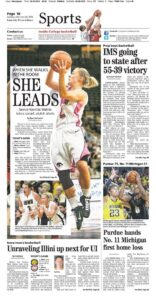An opinion column is a thought-provoking piece where a writer presents their viewpoint on a specific issue, blending personal voice with persuasive techniques. Unlike traditional news reporting, which focuses on delivering facts, an opinion column allows for the writer’s stance to take center stage, supported by logical arguments, anecdotes, and evidence. These columns aim to inform, challenge, or inspire readers by fostering engagement with critical topics, ranging from politics and culture to lifestyle and technology. Through a blend of conversational tone, rhetorical devices, and emotional appeals, an opinion column seeks to resonate with its audience and spark meaningful dialogue.
Visual Elements
Headline
- Definition: A bold, attention-grabbing title that summarizes the writer’s opinion or stance.
- Example: “The Case for a Four-Day Workweek: Productivity Over Tradition”
- Effect: Immediately attracts the reader and signals the topic and tone of the column, sparking curiosity.
Sub-headline
- Definition: A smaller, descriptive line beneath the headline that adds context or detail to the main idea.
- Example: “Shorter workweeks have been shown to increase creativity and mental health.”
- Effect: Provides a concise preview, encouraging readers to delve deeper into the argument.
Callout Boxes
- Definition: Highlighted sections or phrases that emphasize key points or quotes.
- Example: “‘Flexibility fosters innovation,’ says leading economist Dr. Claire Hope.”
- Effect: Directs attention to the column’s pivotal messages, making it easier to retain and understand.
Images/Illustrations
- Definition: Photographs, drawings, or visual elements that complement the topic or add emotional weight.
- Example: An image of workers relaxing in a park to illustrate the benefits of shorter workweeks.
- Effect: Engages visual learners and makes the article more appealing, while reinforcing the argument.
Pull Quotes
- Definition: Excerpts from the text displayed in a larger font to emphasize key statements.
- Example: “The 40-hour week belongs to history, not the future.”
- Effect: Breaks up the text visually and highlights compelling ideas, keeping the reader’s attention.
Charts or Infographics
- Definition: Graphical representations of data or facts related to the column’s argument.
- Example: A bar graph showing productivity levels in companies that adopted a four-day workweek.
- Effect: Makes complex information easier to understand and adds credibility through data visualization.
Linguistic Elements
Hooking Opening Statement
- Definition: A powerful first sentence or paragraph that captures attention and sets the tone.
- Example: “Imagine working fewer hours but achieving more. It’s not just a dream; it’s a reality for many.”
- Effect: Compels the reader to continue by presenting a relatable or intriguing idea.
Clear Position or Thesis
- Definition: The main argument or opinion stated early and unambiguously.
- Example: “The four-day workweek isn’t just possible—it’s essential in today’s fast-paced world.”
- Effect: Provides clarity and direction, ensuring readers know the writer’s stance upfront.
Anecdotes and Relatable Examples
- Definition: Brief stories or relatable scenarios that illustrate the writer’s point.
- Example: “Last year, a tech firm in Tokyo implemented shorter workweeks, and productivity rose by 25%.”
- Effect: Adds a human element, making the argument more relatable and persuasive.
Use of Statistics and Evidence
- Definition: Incorporating data or research findings to substantiate claims.
- Example: “Studies show that 80% of employees feel more focused in a flexible work environment.”
- Effect: Builds credibility and appeals to the reader’s logical reasoning.
Emotional Appeals
- Definition: Language designed to evoke feelings or connect with the reader on an emotional level.
- Example: “Picture parents spending evenings with their children instead of stuck in traffic.”
- Effect: Creates empathy and emotional investment in the argument.
Rhetorical Devices
- Definition: Techniques like rhetorical questions, repetition, or parallelism to emphasize points.
- Example: “If not now, when? If not us, who?”
- Effect: Engages the reader and makes the message more memorable.
Balanced Counterarguments
- Definition: Addressing opposing views and systematically refuting them.
- Example: “Critics argue shorter workweeks could reduce collaboration. However, data suggests otherwise, with remote tools bridging gaps effectively.”
- Effect: Demonstrates fairness and thoroughness, making the argument more persuasive.
Conversational Tone
- Definition: A relaxed, informal writing style that resonates with the reader’s everyday language.
- Example: “Let’s face it—nobody’s productivity peaks after lunch.”
- Effect: Builds rapport with the reader and makes the column engaging.
Call to Action
- Definition: A closing statement that encourages readers to take specific actions or reflect on the issue.
- Example: “Let’s advocate for work schedules that value quality over quantity. Change starts with us.”
- Effect: Leaves a lasting impression and motivates the reader to act or think critically.
Memorable Closing Line
- Definition: A striking final thought that reinforces the article’s argument.
- Example: “The future of work isn’t about how long we work but how well we live.”
- Effect: Ensures the reader remembers the writer’s key message, even after finishing the column.
Sample Guiding Question
- What is the writer’s intention behind the column? Is it to persuade, provoke thought, or inspire action? How effectively is this purpose conveyed?
- Who is the intended audience of the column? How do linguistic choices, tone, and content appeal to this audience?
- How does the headline reflect the column’s argument or central idea? Does the sub-headline complement it by adding context or direction?
- How does the writer hook the reader in the opening paragraph? Is it through a compelling statement, anecdote, or rhetorical question?
- How clearly does the writer articulate their stance? Is the position maintained consistently throughout the column?
- What literary or rhetorical devices are used, and how do they reinforce the argument?
- How does the writer use evidence? Does it effectively substantiate the argument?
- Are opposing viewpoints addressed? If so, how does the writer refute or acknowledge them?
- What tone is adopted, and how does it shape the reader’s response to the argument?
- How does the writer conclude the column? Does the conclusion summarize the key ideas or leave the reader with a thought-provoking statement or call to action?
How is a newspaper article different from an opinion column?
| Aspect | Opinion Column | Newspaper Article |
|---|---|---|
| Purpose | To express the writer’s personal perspective or stance on an issue. | To provide factual, objective information about a recent event or issue. |
| Content | Subjective arguments supported by anecdotes, evidence, and rhetorical devices. | Factual details, backed by verified sources, focusing on the 5Ws and H. |
| Tone | Conversational, critical, or emotive, reflecting the writer’s voice and personality. | Neutral, formal, and professional, maintaining impartiality. |
| Structure | May follow a narrative arc; includes a clear thesis, evidence, and a call to action. | Follows the inverted pyramid style: most important information first. |
| Examples | Topics like “Why Flexible Work Schedules Matter” or “The Case for Clean Energy.” | Topics like “Floods Ravage Coastal Towns” or “Election Results Announced.” |
| Engagement | Aims to provoke thought, persuade, or inspire the audience to act or reflect. | Aims to educate and inform the audience with objective facts. |
| Use of Voice | Strong personal voice and often includes humor, storytelling, or persuasive techniques. | Objective and factual; avoids personal opinions or emotional influence. |
| Target Audience | Readers looking for opinions, analysis, or perspectives on specific topics. | Readers seeking clear, unbiased reporting on current events. |
Must Read: Newspaper Article


